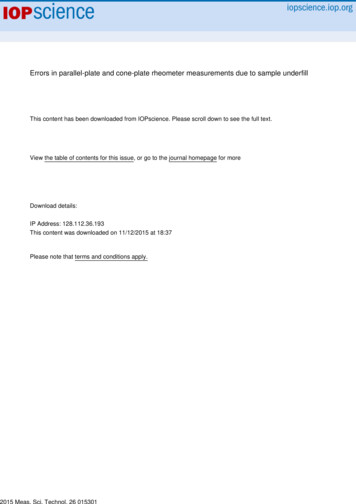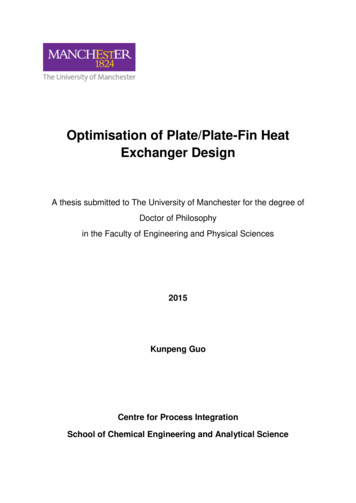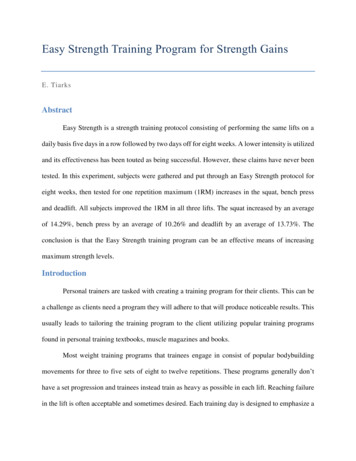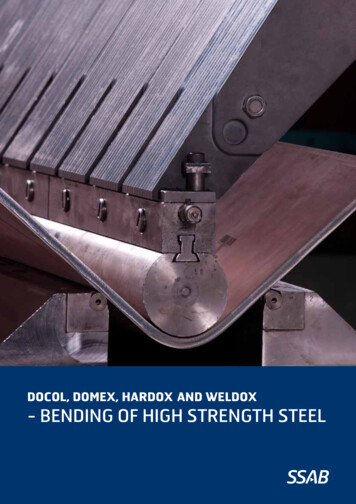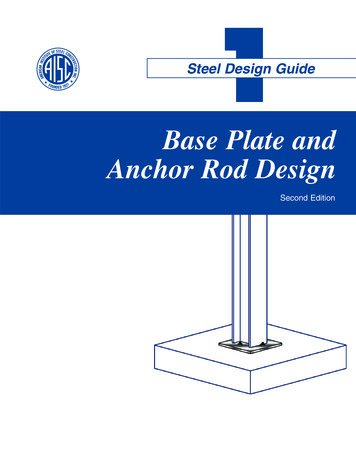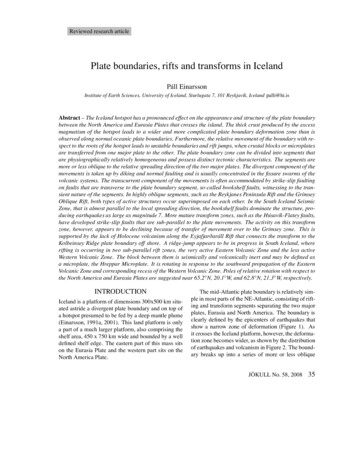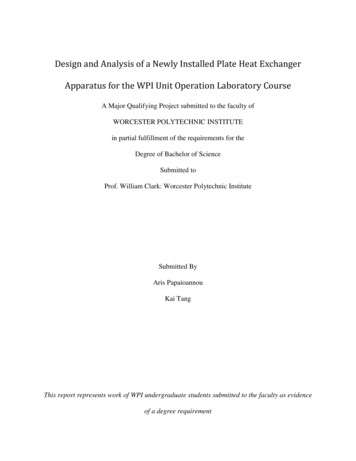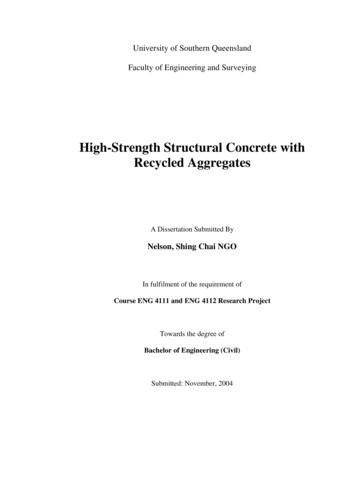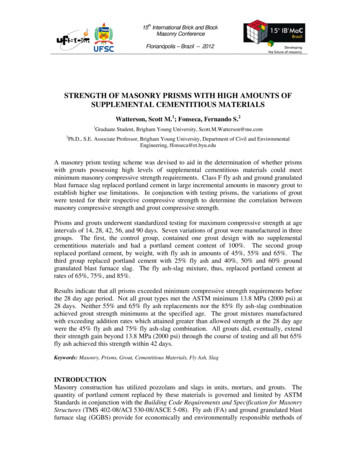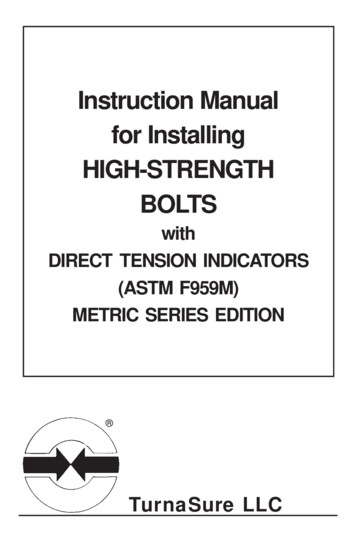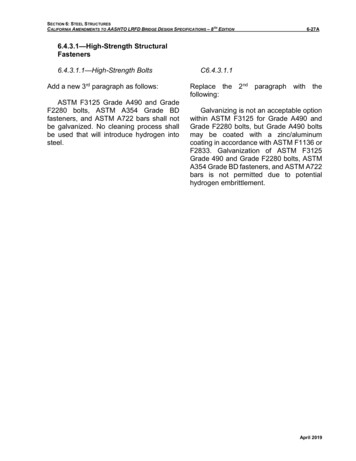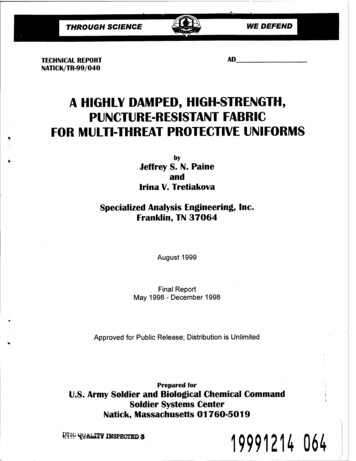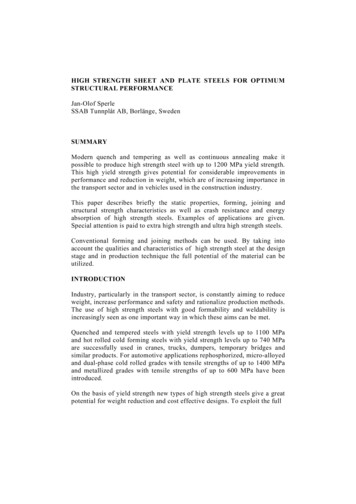
Transcription
HIGH STRENGTH SHEET AND PLATE STEELS FOR OPTIMUMSTRUCTURAL PERFORMANCEJan-Olof SperleSSAB Tunnplåt AB, Borlänge, SwedenSUMMARYModern quench and tempering as well as continuous annealing make itpossible to produce high strength steel with up to 1200 MPa yield strength.This high yield strength gives potential for considerable improvements inperformance and reduction in weight, which are of increasing importance inthe transport sector and in vehicles used in the construction industry.This paper describes briefly the static properties, forming, joining andstructural strength characteristics as well as crash resistance and energyabsorption of high strength steels. Examples of applications are given.Special attention is paid to extra high strength and ultra high strength steels.Conventional forming and joining methods can be used. By taking intoaccount the qualities and characteristics of high strength steel at the designstage and in production technique the full potential of the material can beutilized.INTRODUCTIONIndustry, particularly in the transport sector, is constantly aiming to reduceweight, increase performance and safety and rationalize production methods.The use of high strength steels with good formability and weldability isincreasingly seen as one important way in which these aims can be met.Quenched and tempered steels with yield strength levels up to 1100 MPaand hot rolled cold forming steels with yield strength levels up to 740 MPaare successfully used in cranes, trucks, dumpers, temporary bridges andsimilar products. For automotive applications rephosphorized, micro-alloyedand dual-phase cold rolled grades with tensile strengths of up to 1400 MPaand metallized grades with tensile strengths of up to 600 MPa have beenintroduced.On the basis of yield strength new types of high strength steels give a greatpotential for weight reduction and cost effective designs. To exploit the full
potential of high strength steels the design philosophy and productiontechniques must take into accont factors such as formability, weldability,stiffness, buckling, crush resistance and fatigue.In this paper the high strength steels will be presented with focus on thehigher strength levels. The above factors are exemplified and discussed onthe basis of optimum structural performance in using high strength steels.Most of the test results presented in this paper refer to cold rolled highstrength sheet steel, however, many aspects of the use of these steels aregenerally applicable. Applications are presented where different highstrength steels are successfully used.THE MOTIVES FOR USING HIGH STRENGTH STEELSThe driving forces behind the increasing use of high strength steels are oftenconnected to the wish to achieve the best structural performance at thelowest possible weight and cost. In general, overall economy of the finalproduct is usually the deciding factor. This is based on material cost,production economy and, increasingly, Life Cycle Costs - an analysis of allthe costs and benefits during the entire life of the product.In such an analysis one should for example consider that by using highstrength steel it is possible to reduce material thickness and dead weight of astructure which in turn give higher pay-loads. Lower production weightslead to lower handling costs and less filler material in welding operations.Additionally, modern high strength steels combine several favourableproperties such as high strength, weldability, excellent forming andpunching characteristics and minor variations in physical properties. Allthese factors are of primary importance in keeping production costs down.The environmental advantages of low weight and increased pay-load arealso extremely important today when fuel consumption, exhaust emissionsand the use of finite global resources must be kept to a minimum.The use of high strength steel usually leads to lower material costs since theweight reduction more than compensates for the higher price of highstrength steel. This means that there is a strong motivation to use highstrength steels outside the transport sector and in structures that are regardedas ”simple” such as shelf systems and hinges.
STEEL GRADESAll high strength steel grades produced at SSAB are made by basic oxygenfurnace steelmaking followed by continuous casting. Inclusion control isused to increase formability. Steel gradesand mechanical properties areshown in Table I. This paper primarily refers to Extra High Strength, EHS(450 Re 800 MPa) and Ultra High Strength, UHS (Re 800 MPa) steels.When placing steels in these groups the yield strength for DP steels is theone after 2 % work-hardening and bake-hardening.Table I: Mechanical properties for high strength steel gradesSteel1typeGradeWeldox 500Weldox 700Weldox 900Weldox 1100Domex 350 YPDomex 490 XPDomex 590 XPDomex 690 XPDomex 740 XPDocol 350 YPDocol 500 YPDocol 600 DPDocol 800 DPDocol 1000 DPDocol 1200 DPDocol 1400 DPDogal 350 YPDogal 500 -MA1)HR hot rolledCR cold rolledHDG hot-dip galvanized2)Ec C Mn6 Cr Mo V5Elongation(%)A5 .56.68.17.33.32.32.37MA microalloyedDP dual-phase Ni Cu15(Carbon equivalent, typical values)The Weldox grades are produced in thicknesses 5 - 80 mm. Domex gradesare produced in thicknesses 2 - 10 mm and Docol and Dogal in 0.5 to 2 mm.
The Weldox grades are either thermomecanically processed (Weldox 500) orquenched and tempered (Weldox 700 - 1100) hot rolled microalloyed steelplates.Domex grades are all hot rolled thermomecanically processed microalloyedstrip steels. Docol grades are either cold rolled microalloyed steels (Docol350 - 500 YP) or cold rolled dual-phase steels (Docol 600 - 1400 DP). Dogalgrades, finally, are hot-dip galvanized microalloyed steels.FORMABILITYAll grades mentioned above are intended for cold forming without any extraheating. A low level of non-metallic inclusions and sulphide-shape controlare very important for bend formability and edge ductility in hole expansion.A Domex 690 XP hot-rolled grade can be bent without cracks to a bendingradius of 1.6xt (t sheet thickness). The corresponding value for Weldox700 is 2xt.The dual-phase grades can be work-hardened after forming and bakehardened after paint baking to increase the yield strength by up to amaximum of 300 MPa. Press-forming can be used even on the tensilestrength level 1400 MPa but rollforming is the most suitable method forforming Docol 1200 DP and Docol 1400 DP. The press formability of Docol600 - 1400 DP in comparison with mild steel is illustrated in Figure 1 [1].Fig 1Examples from tests in deep drawing and stretch forming of steelsDC O4 (mild steel), Docol 600 DP, Docol 800 DP, Docol 1000 DP,Docol 1200 DP and Docol 1400 DP
Press hardening using the Plannja process, where boron steel sheets are hotformed in cooled tools, is a very interesting alternative to cold forming forcomplicated parts of very high strength (Re 1200 MPa).WELDABILITYAll grades described in this paper can be welded with conventional weldingmethods. The reason for the good weldability is the lean chemistry of thesteels.The most common welding methods for hot rolled steel grades are manualmetal arc (MMA) and gas shielded arc welding (MAG). For cold rolled andmetallized grades spot welding and MAG-welding are most frequently used.When discussing weldability of high strength steels the matter of mostconcern is normally cold cracking in the heat affected zone (HAZ). Brittlemicrostructures such as martensite of high carbon content and high levels ofhydrogen together with high restraint forces increase the risk of coldcracking. The carbon equivalent CE, being a measure of the richness inchemical composition, is often used as a value to estimate the susceptibilityto cold cracking. If the CE-values given in table I are compared to the CEvalue of 0.4 for an ordinary standard high strength steel St 52-3 (Re 350MPa) it is obvious that Weldox and Domex extra high strength steelsnormally show little risk of cold cracking. For plate thicknesses greater than10 mm preheating is recommended when working with Weldox 900 and1100. The weldability of Weldox and Domex steels is discussed in moredetail in [2] and [3].All Docol cold rolled and Dogal metallized products can be MAG-welded orspot welded, but, it is important to adjust the welding parameters accordingto the alloy content of each grade. For Docol 1200 DP and 1400 DP onlyspot welding to mild steel is recommended.MMA- and MAG-welded EHS and UHS steels often show a narrow softzone in HAZ. In the case of Weldox QT grades and Docol DP grades this ismainly due to tempering and in Domex, Docol and Dogal microalloyedgrades due to loss of precipitation hardening in the microstructure. If thesoft zone is small in comparison to the thickness of the plate or sheet thestrength of the welded joint is not effected due to the high degree ofconstraint.
The width of the soft zone depends mainly on heat input and the thickness.Low heat input is therefore recommended when welding EHS and UHSsteels which have a structural load perpendicular to the weld. In such casesit is also advisable to choose a welding wire which matches the strength ofthe material to be welded.Tensile test results on butt welded joints in Domex cold forming steel andDocol cold rolled steels are shown in Figure 2. It can be seen that the tensilestrength of the MAG-welds in Docol DP steels is somewhat lower than thebase metal strength when the tensile strength exceeds 800 MPa. The lowerheat input in laser welding does not result in such a loss of strength.Tensile strength of weld (MPa)140012001000800600Domex M AG, t 6-8 mmDocol M AG, t 1-2 mm400Docol Laser, t 1-2 mm200200Fig 2400600 800 1000 1200 1400Tensile strength of base metal (MPa)16001800Tensile strength of MAG and Laser welds as a function of base metaltensile strength.STIFFNESSThe use of high strength steel often leads to weight and thickness reductions.Since the Young’s modulus is the same for high strength steel and mild steelthe stiffness decreases when the material thickness is reduced. If thisreduction is not acceptable the stiffness loss can be compensated bychanging the shape of the section.
Sectiont 1.5GradeYield strengthStiffnessWeightLoad carryingcapacityMaterial costFig 3Fe P01220 MPa111125t 1.031Docol 350 YP350 MPa10.731.140.80ChangeMS to HS-27% 14%-20%Reduced weight and cost with unchanged stiffnessFigure 3 illustrates that a small increase in section height of a beam cancompensate for the stiffness loss associated with a thickness reduction, thestiffness being proportional to the square of the section height. This is a veryclear example of the advantage of thinking in terms of the properties of highstrength steel at the design stage.BUCKLINGDecreased thickness can result in buckling. The governing parameter forbuckling is the width to thickness ratio (w/t) rather than the absolutethickness. This means that the risk of buckling is the same for a 1 mm thicksheet in an automotive structure as in a 20 mm thick bridge structure if thevalue of w/t is the same. The critical value of the width to thickness ratio,over which buckling will take place before the yield load is reached, isrelated to the yield strength by(w/t)cr C 1Rewhere (w/t)cr critical width to thickness ratioC constant depending on overall geometryRe yield strength (MPa)
Cross sections which buckle before the nominal stress in the flanges reachesthe yield strength are categorised in cross section class 3 [4]. Cross sectionsthat can be bent plastically without buckling are categorised in section class1 and cross sections in between those limits in section class 2. The value ofC for the limit between section class 2 and 3 is C 200 for flanges in I, T, Cand U sections and C 520 for flanges in box sections, Figure 4.Width to Thickness Ratio w/t25Section Class 3Load bearing capacityreduced by buckling20w15(w/t)2-3 520/ Re10Section Class 1 - 2No bucklingt504005006007008009001000110012001300Yield Strength , Re (MPa)Fig 4Limiting width to thickness ratio (w/t) for bucklingIn order to take full advantage of the properties of high strength steel, crosssections should be in section class 1 or 2. For sections in section class 3there is, however, still the positive effect of increased yield strength on theload-bearing capacity although it will be somewhat reduced by buckling.FATIGUEWhen introducing high strength steels into fatigue loaded structures it isimportant to note that the fatigue strength of welded joints does notnormally increase with the increasing base metal strength. The reason forthis is that the crack-like defects that are present at the weld toes mean thatcrack propagation will feature in the major part of the fatigue life. Since thecrack growth resistance does not differ between mild steel and high strengthsteel, neither does the fatigue strength of the welded joints. This isillustrated in Figure 5 where we also see that if the stress concentration islow or moderate as in holes, radii and recesses, a decreased thickness and ahigher working stress can be balanced by the higher fatigue strength of thehigh strength steel.
The fatigue strength for unnotched base metal is strongly related to thesurface roughness. Domex grades normally have a surface roughness Ra 2and Weldox grades Ra 4 - 8 [5].600Pulsating tensionloading, R 0, N 106Fatigue strength (MPa)500400Base metal, Ra 2Base metal, Ra 6300Specimen with hole, Kt 2,2200Butt weldFillet weld1000100Fig 5200300400 500 600 700Yield strength (MPa)800900 1000Fatigue strength as a function of yield strengthIn order to achieve optimum performance of high strength steels in fatigue
A Domex 690 XP hot-rolled grade can be bent without cracks to a bending radius of 1.6xt (t sheet thickness). The corresponding value for Weldox 700 is 2xt. The dual-phase grades can be work-hardened after forming and bake-hardened after paint baking to increase the yield strength by up to a maximum of 300 MPa. Press-forming can be used even on the tensile strength level 1400 MPa but .
